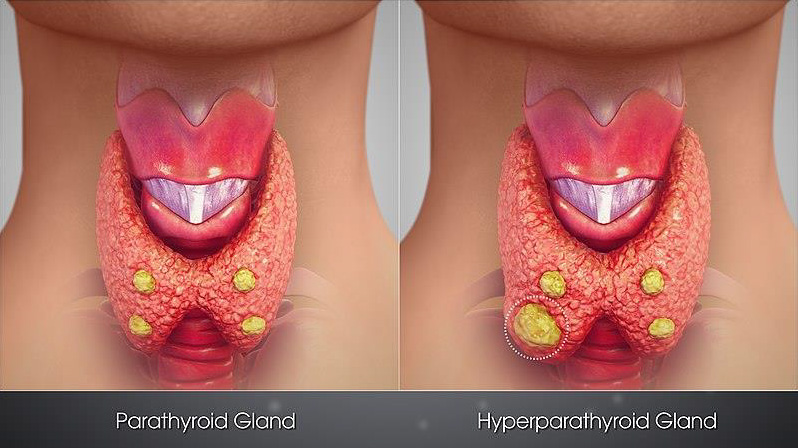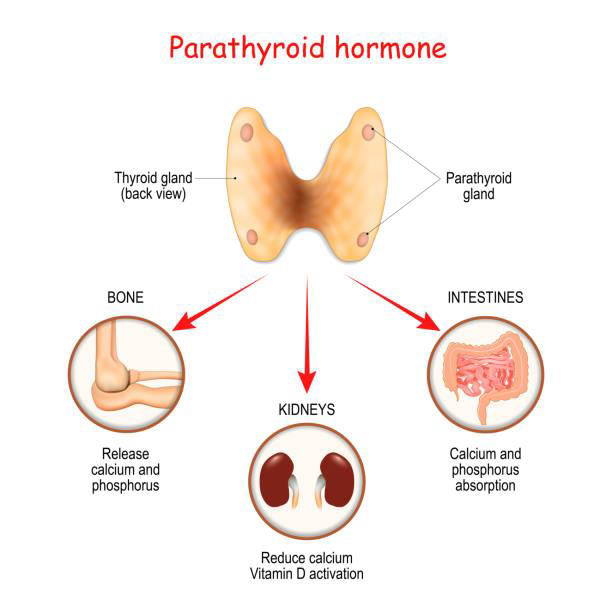Joseph R. Anticaglia MD
Medical Advisory Board
Linda, a 52 year old homemaker, complained of being “tired all the time.” Over the past few years, besides being tired, she experienced trouble concentrating, mood swings, loss of appetite, and forgetfulness. She thought it was connected to the “empty nest syndrome” after her daughter got married, and she was left alone in her apartment. All that changed after she fell and hurt her back.
X-rays of the back reported no broken bones, but they appeared weak and brittle, a condition called osteoporosis. Her doctor ordered lab tests that indicated high levels of calcium in her blood and urine. Her doctor said, “The problem might be connected to the parathyroid gland.”
Image studies demonstrated that one of the parathyroid glands was significantly enlarged. She had successful surgery to remove the benign tumor, and post-op her calcium lab tests returned to be within a normal range. She felt fine after surgery, but prior to surgery, one of Linda’s questions was —
What are the Parathyroid Glands?
Normally, the there are four tiny parathyroid glands (PG) located in the neck just behind the thyroid gland in its connective tissue — two towards the upper lobes of the thyroid and two towards the lower lobe. The number and location of the PG can vary. These miniscule glands are about the size of a “grain of rice” — measuring only six millimeter in length, three mm in width and two mm in thickness.

What Do the Parathyroid Glands Do?
The parathyroids glands punch above their weight; meaning they influence our body’s metabolism much more than you would expect them to do because of their size. They produce, and secrete (release) the parathyroid hormone (PTH) into the bloodstream. The hormone plays a crucial role in regulating the body’s calcium and phosphorous blood levels. In Linda’s case, the parathyroid tumor contributed to her high blood calcium levels — Hypercalcemia, brittle bones, and her other symptoms.
We need calcium for blood to clot, muscles to move, nerves to function, heart to pump blood and for the body to build and maintain strong bones. Too much or too little calcium in our blood can have dire consequences. If there is a low level of calcium in the bloodserum, the chief cells of the parathyroids increase the secretion of the hormone to bring the calcium blood levels back to within a normal range.
The parathyroid hormone regulates calcium levels by stimulating:
- your bones to release calcium into the blood
- your kidneys to conserve calcium
- your intestines to absorb calcium from food

Hyperparathyroidism…
is an overactive parathyroid gland (or glands) that makes too much parathyroid hormone. This overactivity removes calcium from bone causing an increase of calcium in the bloodstream (hypercalcemia).
Overproduction of parathyroid hormone can:
- weaken bone and increase your risk of fractures and osteoporosis.
- lead to kidney stones, because there is too much calcium for the kidneys to handle so that kidneys cannot eliminate the calcium in the urine.
- promote increase absorption of calcium from the G. I. tract
Two types of hyperparathyroidism:
Primary hyperparathyroidism is the result of a disease within the parathyroid glands most commonly caused by a noncancerous — benign growth called an adenoma. Adenoma (single gland disease) accounts for 80 to 85% of hyperparathyroidism. Hyperplasia (enlargement) of two or more parathyroid glands account for most of the other cases.
Secondary hyperparathyroidism is caused by a disease outside of the of the PG. The most common causes are kidney failure, vitamin D deficiency and calcium deficiency
Signs & Symptoms
The symptoms range from mild to severe and early on they may not seem to be related to the parathyroid gland. In the initial stages of the disease, symptoms might include fatigue, loss of appetite, depression and trouble concentrating. Later, people might complain of increased thirst, urinary frequency, forgetfulness and constipation.
Individuals with severe hyperparathyroidism might experience osteoporosis (thinning, weak bones), kidney stones, hypertension and kidney disease, which interferes with the kidney’s ability to filter blood.
Diagnosis
During a routine physical examination, a lab test might indicate an elevated calcium level in the blood. Doctors dig deeper to diagnose the reason for the hypercalcemia by ordering tests which might include:
- Bood tests for kidney function, and vitamin D level
- A 24 hour urine test to evaluate the amount of calcium in the urine
- A DEXA bone density X-ray scan to check for bone loss (osteoporosis)
- Ultrasound to check for kidney stones
- Sestambi/SPECT scan is a nuclear imaging test that can detect an overactive parathyroid gland.
Treatment
Treatment options include:
No Treatment — Close Follow-Up
If the bone density test shows no loss of bone, if your kidneys are functioning normally and blood calcium levels are only slightly elevated, watchful waiting with close follow-up may be your best treatment
Surgery
If a tumor is identified (adenoma) in the parathyroid gland, surgery is the best option; it cures the disease
Medications
There are several treatment options to manage excessive parathyroid hormone secretion and too much calcium in the circulatory system. It’s advisable to consult, for example, an endocrinologist to obtain guidance in the management of this problem.
The four tiny parathyroid glands in the neck control the delicate balance of calcium and phosphorous in our body. These glands “punch above their weight.” to influence almost every cell in our body and work to maintain our well being.
References
- Nazia M. Sadiq; Srividya Naganathan; Madhu Badireddy; Hypercalcemia; September 11, 2021, .StatPearls
- National Institute of Diabetes and Digestive and Kidney Diseases. Primary hyperparathyroidism. March 2019
- Paul Fitzgerald, Endocrine Disorders — Hyperparathyroidism; Diagnosis and Treatment, 2018
- Joseph R. Anticaglia MD; Osteoporosis: What to Know — What to Do; Doctor’s Column, HC Smart, January 2019
Glossary
DEXA — dual energy X-ray absorptiometry
SPECT — single photon emission computed tomagraphy
Addendum
Phosphorous
Calcium and phosphorous are minerals that work together to build strong bones and teeth. Eighty five percent of phosphorous is found in bone and teeth. But phosphorus is also found in DNA, RNA and the body’s key energy source, ATP. It has many other roles and is the second most abundant mineral in the body behind calcium.
Calcium and phosphorous are regulated by the parathyroid hormone and react in opposite ways — As phosphorous levels rise, calcium levels fall because phosphorous binds to calcium reducing the available free calcium in the blood. Their inverse relationship works to maintain metabolic balance in the body
COVID NEWS!
On March 29, 2022, the CDC updated its recommendations to “allow certain immunocompromised individuals and people over the age of 50 who received an initial booster dose at least 4 months ago, to be eligible for another mRNA booster to increase their protection against severe disease from COVID-19.”
This article is intended solely as a learning experience. Please consult your physician for diagnostic and treatment options.

